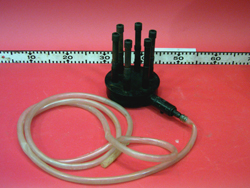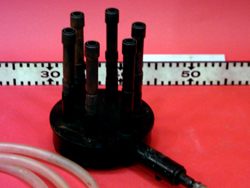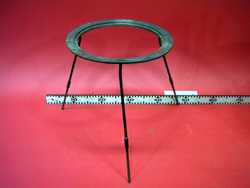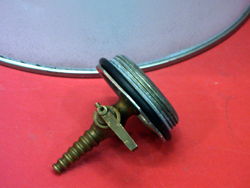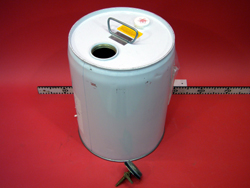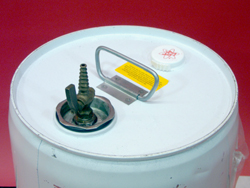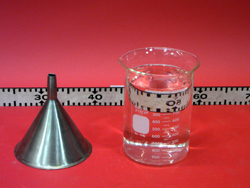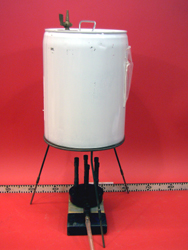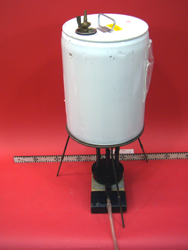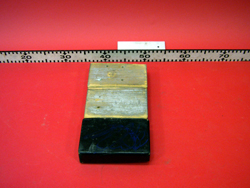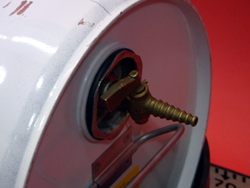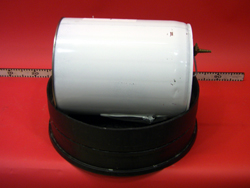20 L Can Crush, 2B30.15
Topic and Concept:
Statics Of Fluids, 2B30. Atmospheric Pressure
Location:
Cabinet: Fluid Mechanics (FM)
Bay: (A1) ??
Shelf: #1 ??
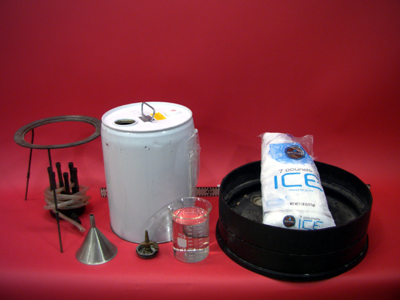
Abstract:
Boil water in a 20L can, seal it up, and place into a cold water reservoir. As the vapor pressure is reduced by cooling, the can collapses.
Equipment |
Location |
ID Number |
|
|
|
20 L can |
|
|
Rooms 2103, 2241, (and 2223 upon request) |
|
|
Burner w/attached gas hose |
|
|
Matches |
|
|
Ring stand |
|
|
Tub |
|
|
Saftey gloves and glasses |
In drawer beneath microwave in lecture demo room |
|
1 L beaker filled with water |
|
|
Funnel |
|
|
Ice (optional) |
|
|
Important Setup Notes:
This demonstration requires a supply of methane gas usually provided by the red and white gas carts found in rooms 2103, 2241, (and 2223 upon request).
- Note this demo can get the near area wet.
Setup and Procedure:
Place the ring stand near the red and white gas cart.
- Place the tub near the stand.
- Set the 20 L can on top of the stand so that the hole side is on top with the hole open.
- Fill the can with at least 1 L of water.
- Fill the tub up to the inner lip (about 2.5" deep) with water. Ice can be added if a shorter cooling time is desired (see last step).
- With the burner securely on the tabletop, connect the burner hose to the red panel valve on the gas cart.
- Put on safety glasses.
- Light the burner by opening the valve and quickly igniting the gas coming out of the burner with a match.
- Place the burner directly beneath the 20 L can, and adjust the flame height accordingly by adjusting the valve.
- Wait for the water to reach boiling (lots of steam will come out of the hole).
- Seal the 20 L can with its cap, and quickly turn of the gas by closing the gas valve.
- With the safety gloves on, move the HOT 20 L can to the tub and place it so that it's now on its side (hole pointing sideways).
- Wait for the can to cool. The water vapor will recondense creating a partial vacuum in the can whereupon the can will be crushed by atmospheric pressure.
Cautions, Warnings, or Safety Concerns:
- Exercise caution throughout this demo. Methane gas is extremely FLAMMABLE, and the boiling water can cause SEVERE BURNS!
Discussion:
When the water is boiled, some of the water undergoes a change of state from liquid to gas. This causes a temporary pressure increase in the can which displaces the original air. When the can is sealed, nearly all of the internal gas is water vapor. The internal pressure is approximately that of atmospheric pressure so that the net force acting on the walls of the can is near zero. Once the can is placed in the ice water, the internal temperature of the can (including the water and water vapor) approaches that of the tub water which is below the boiling point. This causes the water vapor in the can, which provides the internal outward pressure, to condense back into liquid water leaving a partial vacuum in the can. This introduces a significant inward force on the walls of the can. If the inside of the can were to reach perfect vacuum, the inward force would be equal to atmospheric pressure (101325 Pa (N/m2) or about 15 lbs/in2 ) multiplied by the surface area of the can exposed to air. The full surface area of our 20 L cans is typically about 520 in2 or 0.34 m2 which gives us a maximum total force on the can of 780 lbs or 34450 N. This is much more than the structure of the can can withstand.
|
|
|
|
|
|
|
|
|
|
|
|
Videos:
References:
